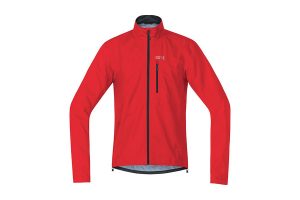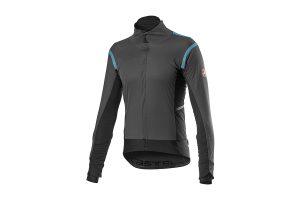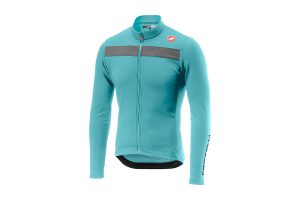The 10 Best Winter Cycling Jackets in 2019
Choosing the right cycling clothing to ride during the winter is definitely not an easy task. Wear one layer too many and you’ll risk being too warm, especially when the pace gets hard and you can’t stop to undress. One layer too less, you might be too cold.
For a good winter jacket, here’s what I’ll be looking out for.
- Breathability. The fabrics should allow sweat vapor to be released when your body temperature goes up.
- Waterproofing keeps you from getting wet during the unpredictable winter weather.
- Windproofing blocks the cold wind chills, especially if you’re riding during dawn or dusk.
It’s not easy for a clothing manufacturer to achieve the perfect balance between breathability, waterproofing, and windproofing while keeping the price tag affordable. In many cases, you’ll need to choose the features that suit your best.
I’ll be sharing with you some of my favorites below.
A Quick Glance : Our Favorite Cycling Jackets for Winter
Value for Money Picks
Gore Wear C3 Active
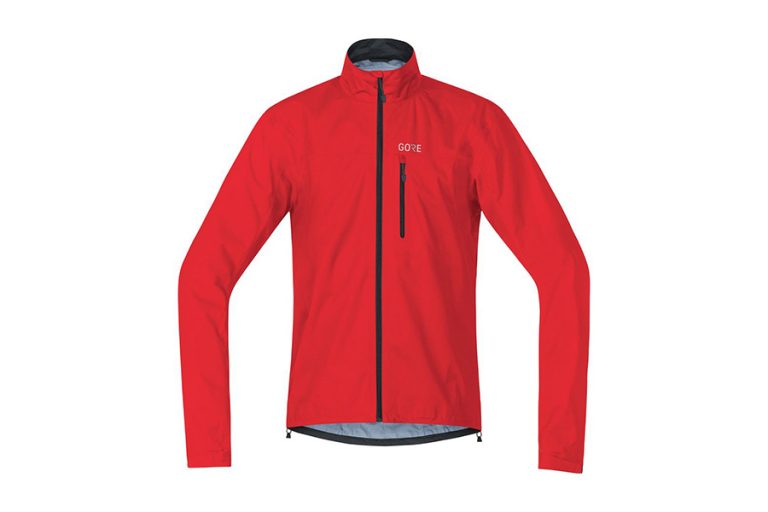
- Breathability : 4/5
- Waterproofing : 5/5
- Windproofing : 5/5
If you’re looking for a cycling jacket that’s tough in the rain and snow, the Gore Wear C3 Active Jacket might just be that one. It’s budget-friendly and sits in the mid-range of Gore Wear’s lineup.
The Gore Tex material is famous for keeping you dry from the inside while maintaining breathability especially when you’re riding hard to reach home in no time. Although it’s not using the famed Gore Tex Shakedry fabrics found in the top-of-the-line models, it will hold up well in light to medium showers.
It fits snugly around the body to avoid the flapping noise that is associated with a lot of cycling jackets. Also, the fact that you can crumple it up and stow it away into a jersey pocket is a great advantage. You definitely don’t need this jacket when it’s dry out, but you’ll be happy you have it when the rain starts.
- Pros : High-quality materials from a very reputable outdoor brand.
- Cons : Limited color choices with bright red, lime green, and the standard all-black.
Castelli Perfetto RoS Convertible
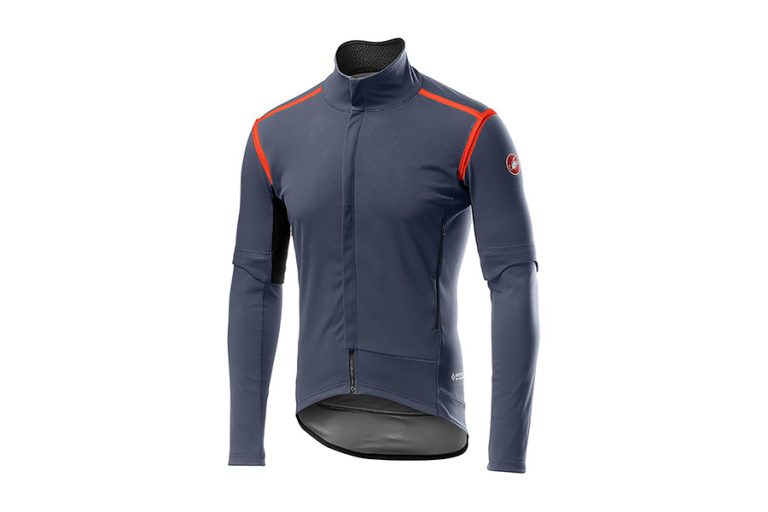
- Breathability : 3/5
- Waterproofing : 3/5
- Windproofing : 5/5
The Castelli Perfetto RoS (Rain or Shine) Convertible Jacket is for serious riders who need a wind-resistant jacket that’s also excellent at dealing with harsh weather conditions.
The first thing you’ll notice is the word Convertible. The unique feature is you can easily convert it to a short-sleeved jacket when the temperature warms up. There are hidden zippers underneath the flaps near the elbow to remove the sleeves, which then can be stored inside the jersey’s pockets.
In this latest version of the Perfetto RoS jacket, Castelli now uses Gore’s Infinium 205 Warm fabrics instead of the Gore Windstopper fabrics to further improve the water protection and heat-trapping capabilities.
As far as we know, this is the only convertible winter jacket on the market and it’s available in five different colors.
- Pros : Gore’s Infinium softshell fabric is warm and yet very breathable during hard rides.
- Cons : Not fully waterproof to be used as a rain jacket.
High Quality Picks
Castelli Alpha RoS 2
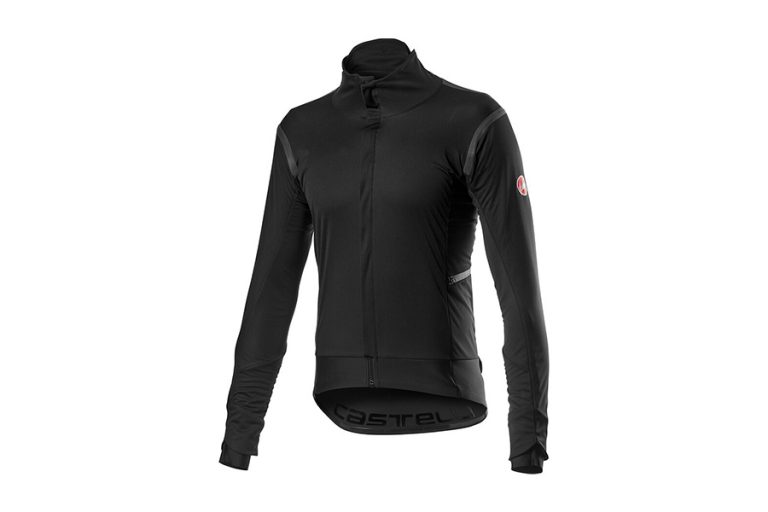
- Breathability : 3/5
- Waterproofing : 4/5
- Windproofing : 5/5
Designed for the cyclist who isn’t afraid of below-freezing temperatures, the Castelli Alpha RoS 2 is the ultimate winter cycling jacket, allowing you to pour on the miles in the harshest of conditions.
The unique thing about the Castelli Alpha RoS 2 (Rain or Shine) is its double-layered front panels, which are made up of a Gore-Tex Infinium wind outer and an inner insulation layer. To some, it can look like you’re wearing a jacket with a jersey underneath, but in fact, it’s just one piece. This is a great feature, especially when the weather warms up. Just unzip the outer layers.
We also like the high-neck design, which does a great job of cutting out cold air to the chest. Combine that with the fitted chest, and you won’t have to worry about getting cold on those long winter rides.
Of course, this type of warmth doesn’t come cheap. The Castelli Alpha RoS 2 is one of the most expensive options on our list and is definitely more of a luxury item. But for those who can afford it, you won’t be disappointed.
- Pros : Everything you’d want in a winter jacket – warm, windproof, and versatile with its dual front panels.
- Cons : Be prepared to pay more.
Assos Mille GT
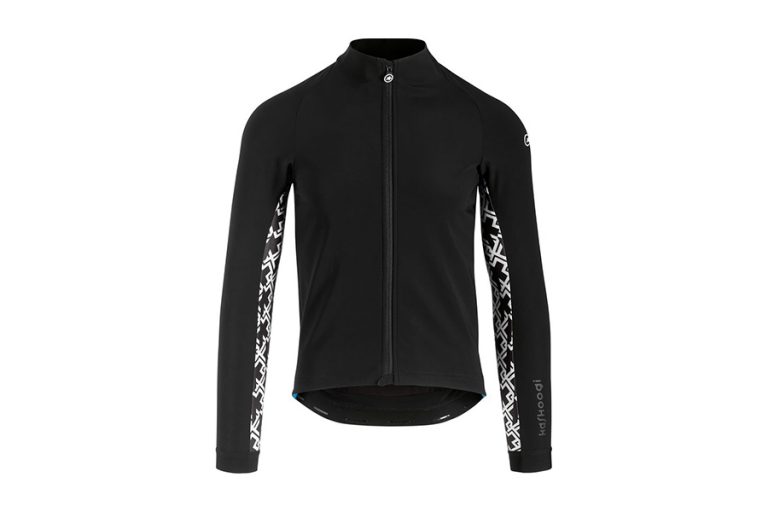
- Breathability : 4/5
- Waterproofing : 5/5
- Windproofing : 5/5
There’s a lot to like about the Assos Mille GT winter jacket, especially its incredible fit, but the ability to let you breathe and move around comfortably.
This is due to the Raglan cut in the sleeves that give the entire jacket a full range of motion without feeling tight or restrictive. It’s important to note that sizing can run small for some.
To ensure maximum breathability and comfort, Assos uses two different fabrics for the front and rear panels. The NEOS Medium front panel is water-resistant and windproof, while the NEOS Light back panel is lighter, making it breathable while sacrificing a bit of windproof-ness.
As with a lot of Assos cycling apparel, be prepared to pay a higher price tag for the Assos Mille GT jacket.
- Pros : Warm, comfortable, and breathable fabrics.
- Cons : Sizing runs very small, not ideal for larger-sized riders.
Pearl Izumi Pi Amfib
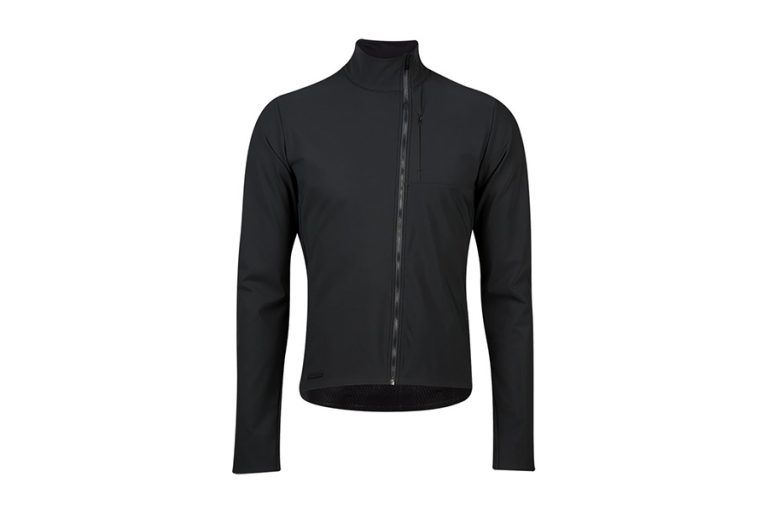
- Breathability : 4/5
- Waterproofing : 3/5
- Windproofing : 5/5
For the ultimate winter-riding experience, the Pearl Izumi Pi Amfib jacket is a premium product that will keep you warm while you pound out the miles during the winter months.
A blend of natural fibers, including the super-warm Merino wool, allows you to ride comfortably in sub-freezing temperatures. But it’s the other features, like the silicone grippers at the hem to keep a tight fit, and the full-length zipper, which can cool you down in case you get too warm, that really makes it a winner.
If you’re a dedicated cyclist, though, who wants to knock out lots of training this winter, the Pearl Izumi Pi Amfib jacket is a great option to keep you comfortable on the roads.
- Pros : Plenty of pockets – 2 at the back and 3 at the front.
- Cons : Only available in graphite color.
Long Sleeve Winter Jersey Picks
Castelli Puro 3
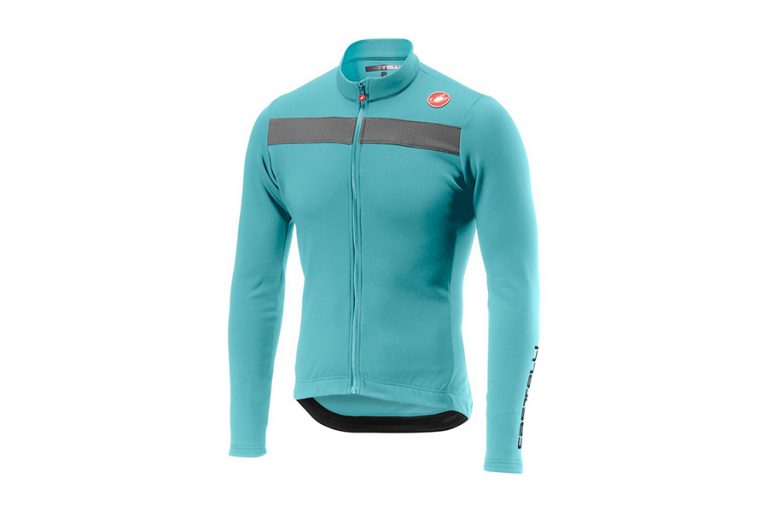
- Breathability : 4/5
- Waterproofing : 1/5
- Windproofing : 3/5
The Castelli Puro 3 is designed for those living in areas with mild winter conditions with temperatures not dropping below 10°C / 50°F. For some, this is also the ideal jersey for late fall or early spring.
Depending on the riding conditions and temperature, the Castelli Puro 3 can be used in several ways. Pair it with a winter base layer, or wear it over a long sleeve jersey when it’s cold, or pair it with a summer base layer on slightly warmer days.
The thicker fleece inner provides most of the insulation but does note that it’s not windproof or water-resistant. And it’s definitely not for those wet winter days.
As with a lot of Castelli’s apparel, the sizing can run small for some people.
- Pros : Comes in 5 different colors to choose from
- Cons : Not ideal if temperatures fall below 10ºC/50ºF.
Gore Wear C3 Thermo Jersey
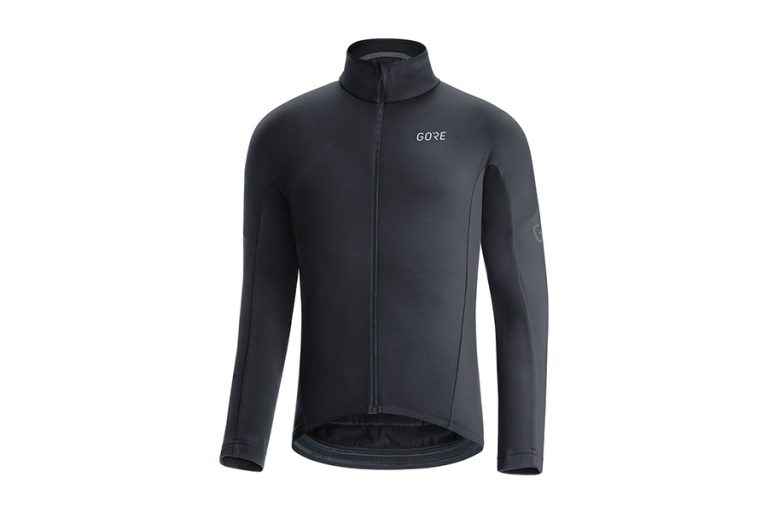
- Breathability : 5/5
- Waterproofing : 2/5
- Windproofing : 5/5
Don’t plan on wearing the Gore Wear C3 Thermo jersey on a crisp fall day. You’ll want to save this kit for those really cold days come winter.
As a thermal jersey, this is designed as an extra layer for those extra chilly days, perhaps under a wind-breaking jacket. It also doubles nicely as a winter shell under a jacket when temperatures start dropping below freezing.
So, really the only downside to this jacket is that it may be too warm for your long bike rides. If you’re only going out for an easy 10 miles on a cold morning, it should suffice.
- Pros : Comes in four colors, three of which are nice and bright for cycling.
- Cons : Be prepared to pay a premium.
Winter Cycling Jackets Buying Guide
1. Hardshell vs. Softshell
The first point to consider when you’re gearing up to make a winter jacket purchase is the level of packable portability you’ll need out of your clothing.
Softshell Jackets
Some cyclists enjoy the ease of being able to take a jacket off, roll it up, and stuff it in the back pocket or under the back of the jersey when the sun comes out and warms everything up.
If that sounds like you, then you’d probably prefer a softshell jacket. They are more wind and waterproof than your typical long-sleeve jerseys while also giving better warmth. The nice thing about a softshell jacket is that when you feel it has done the job, you can stow it away without much thought.
Hardshell Jackets
If the winter weather gets rough in your area and you don’t foresee much need for modularity when it comes to your cold-weather layers, then you might want to consider a hardshell jacket.
They are often made with weather-impermeable materials such as Gore Tex that provide more protection against the winter chill, wind, and water.
On the downside, they don’t pack up very easily.
Geek Tip : Consider wearing softshell jackets when the weather conditions could get ugly but there’s a decent chance of fair weather as well, and hardshell jackets when it just looks plain grim outside.
2. Breathability Ratings
When considering the breathability of your jacket, think about the type of effort you’ll be making while wearing it.
Are you doing endurance pace or interval training? Or going full gas?
For example, if you’re doing Zone 5 efforts up your local hill, odds are you’ll be plenty warm after the first few intervals and won’t need much in the way of a winter jacket.
But if you’re just looking for a warm and dry way to commute to and from work or just cruising around the neighborhood, you can afford to wear a slightly thicker one.
The more weather-proof a winter jacket is, the less breathable it will be.
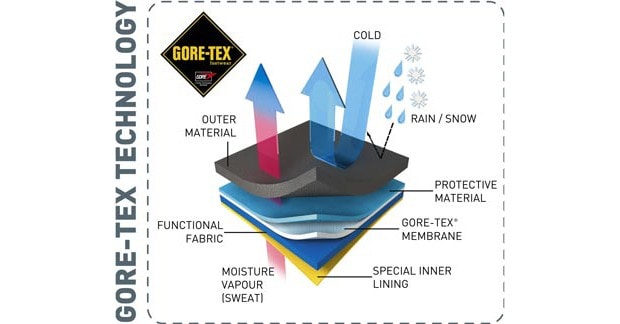
Fabrics like Gore Tex are incredible for keeping you dry and toasty but quite poor when it comes to keeping airflow going.
For a jacket to have windproof qualities, the permeability and venting of the jacket will be minimal.
Geek Tip : If you’re looking to do higher intensity efforts, keep your jacket light and vented.
If you’re riding at an easy pace and don’t produce much sweat while out, then feel free to layer on the warmth.
3. Waterproof Ratings
Winter jackets are waterproof to a certain extent.
What good would a winter jacket be if it didn’t shed water?
As the waterproof values of your jacket rise, its breathability will decrease. So that is something to consider. However, if you live in a region that sees plenty of rain, breathability will come in second to staying dry.
One major point to watch out for when selecting a winter jacket is the difference between a jacket being waterproof vs. water-resistant.
While the difference in wording may be subtle, the reality is not. Water-resistant jackets typically have a light DWR (Durable Water Resistant) coating that won’t keep you dry in a heavy downpour.
The DWR coating is what you’ll typically find on softshell jackets and is meant to keep light rain and showers at bay, but not much more.
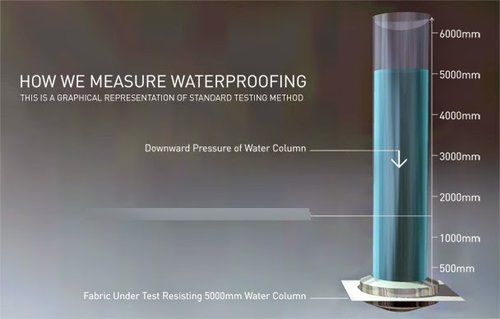
Truly waterproof jackets will be storm-worthy barriers against the rain regardless of how hard it comes down. The waterproof rating is measured by placing the fabric under a 1″ x 1″ tube.
A 10,000mm rating fabric would only start leaking water once the tube is filled up to 10,000mm (10 meters), 20,000mm for 20 meters, and so on.
Here’s the industry’s definition for waterproofing ratings.
- Less than 10,000mm. Minimal protection for activities like running and hiking in intermittent light rain and snow.
- 10,000 – 15,000mm. Medium protection for activities like hiking and skiing in moderate rain, snow, and wind.
- 15,000 – 20,000mm. Excellent protection for most activities in moderate rain, snow, and wind, with intermittent heavy rain and snow.
- More than 20,000mm. Extreme protection for persistent heavy rain, heavy snow, high winds, and very wet environments. Ideal for activities like mountaineering, ice climbing, backcountry skiing, and kayaking.
Geek Tip : Check the waterproof ratings of your jacket before purchasing and make sure it’s at least 15,000mm.
4. Windproof-ness
Nothing cuts cyclists down faster than the cold wind chill, and no feature in a jacket will be as valuable to you as its windproof-ness.
To this extent, you’ll want to ensure a good and proper fit for your jacket. Otherwise, the windproof rating of your jacket will lessen and you’ll feel the chill sooner.
5. Size and Fit
Sizing can vary across different brands or sometimes within the same brand itself.
Use the size chart as a starting point, then look up the user reviews where you’ll find a lot of information about sizing especially if there are people who have a similar height and weight to you.
More importantly, keep in mind that you’ll be wearing at least one base layer underneath when you’re riding. Sometimes, you’ll even need a second layer, which is usually your regular cycling jersey.
And then the winter jacket as the outer layer.
Geek Tip : You might want to go one size up if you’re wearing multiple layers beneath the winter jacket.
6. Extra Features
Since the jacket will be your outermost layer and will be meant to keep bad weather conditions as far away from you as possible, don’t favor those that have rear pockets.
If you absent-mindedly place a phone or some other value that can be damaged in rain or adverse conditions, you’ll be unpleasantly surprised after coming out of a deluge.
Instead, look for taped seams for waterproof efficiency, vents for adding breathability, a high neck to keep the chill off of your neck, and reflective details for visibility on grey days are all much more important features that you’ll be happy to have.
Frequently Asked Questions
1. What’s the best way to dress up for winter cycling?
It depends on how cold the winter gets at your location and how much the temperature varies during the ride.
Generally, here’s what I do:
- Mild winter (15°F / 10°C). You can get away with wearing a winter base layer, a long sleeve cycling jersey with a long sleeve vest over the top. If the weather warms up, you can remove the vest and keep it in your pockets.
- Deep winter (32°F / 0°C). You’ll need a proper winter jacket with a winter base layer underneath, at the minimum. In some cases, you might need an extra layer of a cycling jersey.
- Big variation in temperatures. Go with the layering strategy. Have a softshell jacket as the outer layer which you can then remove and stash in your back pocket when the weather warms up.
2. What’s the lowest temperature I can go with these jackets?
Winter jackets are meant to be worn together with a base layer under them. With this combination, you can go as low as 23°F / -5°F to 14°F / -10°C.
Bear in mind that your body will generate heat as you ride, so you might feel slightly cold at the start. You’ll be all warm and toasty after about 15 minutes into the ride.
3. How do I wash the jacket?
3. How do I wash the jacket?
The very first thing you should do is to read the washing instructions, usually located on the inner parts. Although the general washing instructions are similar, some have specific washing needs. So be aware of that.
Read More : How to Care for Your Cycling Kits
Here are a few key pointers you want to keep in mind.
- Close all the zips and velcro straps, and turn it inside out.
- Wash in lukewarm water around 86°F / 30°C.
- If you’re using machine wash, place it in a washing bag and use the delicate function.
- Use only a small amount of liquid detergents. Avoid powder detergents and fabric softeners.
- Let it hang dry.
- The water-repellent properties can be reactivated by tumbling it dry in low temperatures. Only do this after you hang it dry, and it’s just slightly damp.

